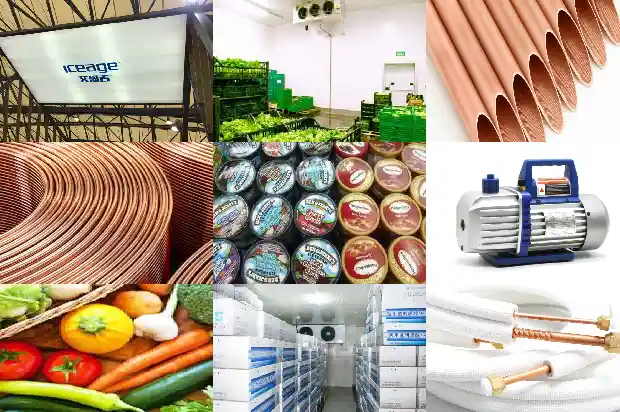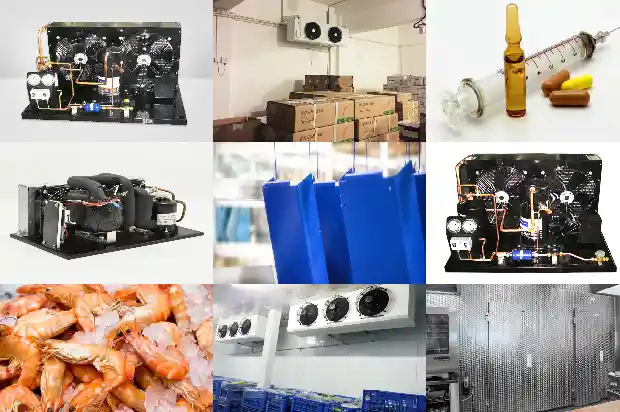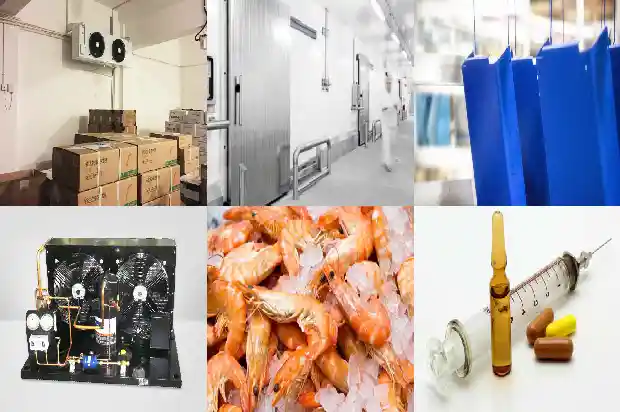Introduction to the Components of a Cold Storage Unit and Common Issues in Cold Storage Units
2024-08-29
Cold storage is a place that maintains a certain temperature and humidity condition in the storehouse through artificial refrigeration. It is mainly used for the freezing processing and refrigeration of food, and related items (chemical products, pharmaceutical products, etc.) that need to be stored at a constant temperature. For controlled atmosphere storages, the proportion of oxygen and carbon dioxide gas components also needs to be controlled to better ensure the quality of food storage. Cold storages mainly include refrigeration machine rooms, storehouses, transformer and distribution rooms, etc.
Types of cold storages:
High-temperature cold storage (constant temperature storage): The refrigeration design temperature is 15 - 5°C.
Medium-temperature cold storage (refrigerated storage): The refrigeration design temperature is 5 - -5°C.
Low-temperature cold storage (freezing storage): The refrigeration design temperature is -18 - -25°C.
Ultra-low-temperature cold storage (deep cold storage): The refrigeration design temperature is -45 - -60°C.
Quick-freezing storage (rapid freezing storage): The refrigeration design temperature is -35 - -40°C.
High-temperature cold storage (constant temperature storage): The refrigeration design temperature is 15 - 5°C.
Medium-temperature cold storage (refrigerated storage): The refrigeration design temperature is 5 - -5°C.
Low-temperature cold storage (freezing storage): The refrigeration design temperature is -18 - -25°C.
Ultra-low-temperature cold storage (deep cold storage): The refrigeration design temperature is -45 - -60°C.
Quick-freezing storage (rapid freezing storage): The refrigeration design temperature is -35 - -40°C.
Components of cold storages: enclosure structure; compression refrigeration unit; solenoid valve, sight glass; expansion valve; evaporator (air cooler); system connection pipes; electrical control system (fully automatic computer control cabinet); refrigeration auxiliary equipment (such as cooling towers, pressure tanks, water pumps, etc.).
Enclosure structure: According to the structural form, cold storages are divided into civil construction type and assembled type.
Civil construction cold storage: It is mainly composed of enclosure structure and load-bearing structure. In addition to being able to withstand the invasion of wind and rain from the outside, its external enclosure structure must also have heat insulation and moisture-proof functions. Therefore, in the construction process of civil cold storages, there are more construction procedures, large workloads, and long construction periods. Because of its good insulation effect and relatively less influence from the outside, it is widely used in some large fruit and vegetable production and wholesale bases and some meat and poultry processing plants.
Assembled cold storage: The cold storage body is mainly composed of insulation boards. The insulation boards of cold storages are all sandwich panels. The inner and outer surfaces of sandwich panels are mostly glass steel plates, color steel plates, and there are also aluminum alloy plates or other plastic plates. The sandwich insulation material is mostly rigid polyurethane.
Civil construction cold storage: It is mainly composed of enclosure structure and load-bearing structure. In addition to being able to withstand the invasion of wind and rain from the outside, its external enclosure structure must also have heat insulation and moisture-proof functions. Therefore, in the construction process of civil cold storages, there are more construction procedures, large workloads, and long construction periods. Because of its good insulation effect and relatively less influence from the outside, it is widely used in some large fruit and vegetable production and wholesale bases and some meat and poultry processing plants.
Assembled cold storage: The cold storage body is mainly composed of insulation boards. The insulation boards of cold storages are all sandwich panels. The inner and outer surfaces of sandwich panels are mostly glass steel plates, color steel plates, and there are also aluminum alloy plates or other plastic plates. The sandwich insulation material is mostly rigid polyurethane.
Compression refrigeration unit: According to the different cooling methods of condensers, it is divided into air-cooled unit and water-cooled unit. Components of compression refrigeration unit: compressor, condenser, liquid receiver, drying filter, pressure controller, high and low pressure gauges, connection pipes. Compressor is the heart of the refrigeration system. It continuously extracts the refrigerant vapor that has completed the heat absorption process and vaporized in the evaporator, maintaining the low temperature and low pressure in the evaporator. Continuously compress the low-temperature and low-pressure refrigerant gas into high-temperature and high-pressure refrigeration gas to provide power for the refrigeration cycle, thereby realizing the refrigeration cycle of compression - condensation - expansion - evaporation (heat absorption) - compression.
Types of compressors: semi-hermetic, fully hermetic, open type; rotor, scroll, piston, screw.
Fully hermetic scroll compressor:
Condenser: The function of condenser - heat exchange equipment. Transfers the heat of the high-temperature and high-pressure refrigerant vapor from the compressor to the surrounding medium - water or air, and cools it into a low-temperature and high-pressure liquid. It is a necessary equipment for outputting heat to the outside of the system.
Types of condensers: air-cooled type (referred to as air-cooled or air-cooled type), water-cooled type (referred to as water-cooled type), evaporative type.
Liquid receiver: A container for storing and supplying high-pressure liquid refrigerant. It stores the liquid refrigerant from the condenser and adjusts and stabilizes the circulation amount of the refrigerant to adapt to changes in working conditions. It is usually installed behind the condenser (air-cooled unit). Water-cooled units have liquid storage functions and generally do not install liquid receivers.
Drying filter: Removes moisture and dirt in the system to prevent ice blockage or dirty blockage in the system. Purification equipment of refrigeration system.
Pressure controller: Controls high and low pressure. When the exhaust pressure is too high or the suction pressure is too low, the controller immediately acts to cut off the pressure control circuit and stop the compressor.
Note: When the high pressure is too high, after troubleshooting the fault and with the consent of technical personnel before starting the machine, reset the manual reset button.
Pressure gauge: The pressure gauge shows the high pressure value and the low pressure value. Difference between high and low pressure gauges: high pressure gauge range (-0.1 - 3.8 MPa); low pressure gauge range (-0.1 - 1.8 MPa).
Units of pressure gauge readings: MPa, kgf/cm2, Psi; 1MPa≈10 kgf/cm2 = 145Psi; Equipment managers should be able to correctly read its pressure value.
Solenoid valve and sight glass: The function of solenoid valve is to control the flow of refrigerant to cut off or open the liquid supply to the system. The function of sight glass is to observe the condition of refrigerant in liquid pipeline and the water content of refrigerant.
Types of compressors: semi-hermetic, fully hermetic, open type; rotor, scroll, piston, screw.
Fully hermetic scroll compressor:
Condenser: The function of condenser - heat exchange equipment. Transfers the heat of the high-temperature and high-pressure refrigerant vapor from the compressor to the surrounding medium - water or air, and cools it into a low-temperature and high-pressure liquid. It is a necessary equipment for outputting heat to the outside of the system.
Types of condensers: air-cooled type (referred to as air-cooled or air-cooled type), water-cooled type (referred to as water-cooled type), evaporative type.
Liquid receiver: A container for storing and supplying high-pressure liquid refrigerant. It stores the liquid refrigerant from the condenser and adjusts and stabilizes the circulation amount of the refrigerant to adapt to changes in working conditions. It is usually installed behind the condenser (air-cooled unit). Water-cooled units have liquid storage functions and generally do not install liquid receivers.

Drying filter: Removes moisture and dirt in the system to prevent ice blockage or dirty blockage in the system. Purification equipment of refrigeration system.
Pressure controller: Controls high and low pressure. When the exhaust pressure is too high or the suction pressure is too low, the controller immediately acts to cut off the pressure control circuit and stop the compressor.
Note: When the high pressure is too high, after troubleshooting the fault and with the consent of technical personnel before starting the machine, reset the manual reset button.
Pressure gauge: The pressure gauge shows the high pressure value and the low pressure value. Difference between high and low pressure gauges: high pressure gauge range (-0.1 - 3.8 MPa); low pressure gauge range (-0.1 - 1.8 MPa).
Units of pressure gauge readings: MPa, kgf/cm2, Psi; 1MPa≈10 kgf/cm2 = 145Psi; Equipment managers should be able to correctly read its pressure value.
Solenoid valve and sight glass: The function of solenoid valve is to control the flow of refrigerant to cut off or open the liquid supply to the system. The function of sight glass is to observe the condition of refrigerant in liquid pipeline and the water content of refrigerant.
Thermal expansion valve: The throttle valve of refrigeration device.

Air cooler: Heat exchanger for refrigerant to absorb heat at low temperature. In the evaporator, the refrigerant liquid coming from the expansion valve boils at a lower temperature, turns into gas, and absorbs the heat of the cooled object or medium to achieve the purpose of cooling and refrigeration. According to the air convection mode, it is divided into air cooler and coil.
Electric control box of cold storage:
The electric control box of cold storage contains one or more low-voltage switchgear and related control, measurement, signal, protection, regulation and other equipment. It is a combination assembled together completely by structural components by the manufacturer and completes all internal electrical and mechanical connections.
The electric control box of cold storage contains one or more low-voltage switchgear and related control, measurement, signal, protection, regulation and other equipment. It is a combination assembled together completely by structural components by the manufacturer and completes all internal electrical and mechanical connections.

Common fault analysis and treatment of cold storages:
- Excessive exhaust pressure:
Hazards: Increased wear of compressor due to overheating, deterioration of lubricating oil, decreased refrigeration capacity, and increased power consumption.
Cause analysis:
- Air and other non-condensable gases are left in the system during vacuum pumping;
- The ambient temperature is too high (easily occurs in summer) or the ventilation is poor;
- Insufficient cooling water volume or too high water temperature (water-cooled unit);
- The water-cooled condenser is too thickly fouled; the air-cooled condenser is too dusty;
- The condenser motor or fan blade is damaged.
- Low suction pressure
Hazards: Increased wear of compressor due to overheating, decreased refrigeration capacity, and increased power consumption.
Cause analysis:
- The frost layer of air cooler is too thick;
- The motor or fan blade of air cooler is damaged;
- Refrigerant leakage.
- Excessive exhaust temperature
Hazards: Deterioration of lubricating oil and wear of internal mechanical components of compressor.
Causes:
- Excessive high pressure;
- Excessive low pressure;
- Excessive load of cold storage.
Note: The exhaust pipe temperature shall not exceed 135°C at most.
- Refrigerant liquid return
Refrigerant liquid return: Excessive refrigerant liquid enters the crankcase of the compressor.
Hazards: Refrigerant liquid dilutes lubricating oil and causes wear on sliding surfaces.
Causes:
- Blockage of air flow passage;
- Fan motor is damaged or fan blade is too dirty;
- A large amount of frost forms on evaporator fins or coils;
- Incorrect air circulation supply or return position;
- Sudden change in load (hot defrosting or condenser).
- Compressor start-up with liquid
Phenomenon: A large number of bubbles (oil foam) can be observed from the sight glass when starting up.
Hazards: Liquid hammer occurs.
Causes:
- Long-term shutdown, refrigerant liquid enters the crankcase;
- The ambient temperature of the compressor is too low;
- The crankcase heater is not energized;
- Excessive refrigerant charging.
- Lack of oil in compressor:
Hazards: Wear or scratch damage on the surface of all sliding parts inside the compressor.
Causes:
- Improper design and installation of pipeline oil return;
- Excessive frequency of compressor start-up and shutdown;
- Too low load or excessive frosting;
- Refrigerant leakage.
- Difficulty in cooling:
Causes:
- Too much incoming goods or too high incoming temperature.
- The cold storage door is not closed tightly or opened too many times.
- The insulation layer of cold storage or pipeline is damp or damaged, and there is serious cold leakage (condensation).
- There is oil stain or frost layer on the evaporator, and the heat transfer efficiency decreases.
- Refrigerant leakage or excessive charging.
- The suction and discharge valve plates of the compressor are damaged, resulting in decreased refrigeration capacity.
- The thermal expansion valve is out of control or there is a blockage in the system.
Related Articles
- Introduction to Inspection and Handling Methods for Refrigerant Leak in Cold Storage
- Introduction to Control Valves in Refrigeration Systems
- Introduction to Basic Types of Cold Storage
- Introduction to Lithium Bromide Absorption Chillers
- Introduction to the Advantages of Dual - temperature Cold Storage
- Introduction to Various Water Tanks in Air - conditioning Systems
- Introduction to the Cleaning Processes and Methods of Heat Exchangers and Cooling Towers
- Introduction to Six Kinds of Two-stage Compression Refrigeration Systems
- Introduction to Key Points of Compressor Grouping in Quick-freezing Cold Storage
- Introduction to the Construction and Features of Cold Storage in Cold Chain Logistics
- All-round Introduction to Condensers and Evaporators!
- Introduction to Vapor Barrier of Cold Storage and Moisture Protection of Equipment
- Introduction to Oil Collector in Refrigeration System
- Technical Introduction of Process Cooling Water System
- Introduction to Air-cooled Chiller
- Introduction to Five Classification Functions of Cold Storage Installation for Refrigeration
- Introduction to Precooling Methods for Fruits and Vegetables
- Introduction to the Relationship between Refrigerants and Cold Storage Temperatures
